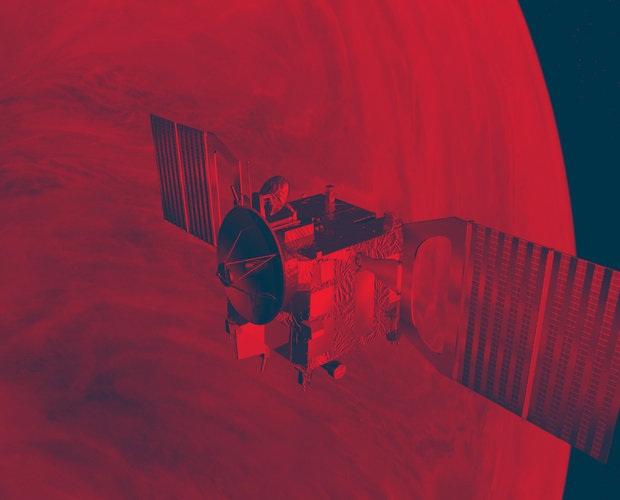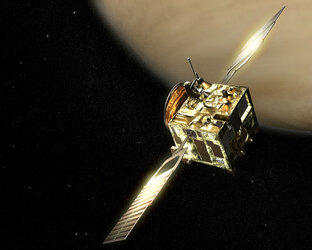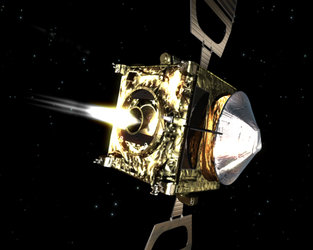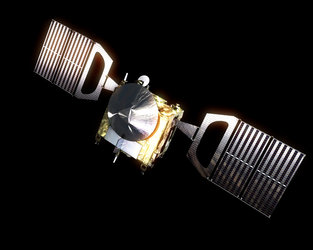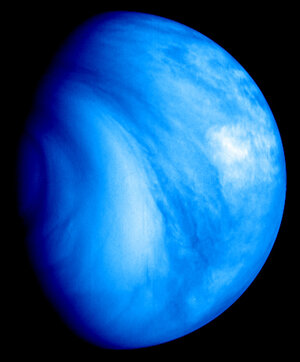Unexpected detail in first-ever Venus south pole images
ESA's Venus Express has returned the first-ever images of the hothouse planet’s south pole from a distance of 206 452 kilometres, showing surprisingly clear structures and unexpected detail. The images were taken 12 April during the spacecraft’s initial capture orbit after successful arrival on 11 April 2006.
Engineers have lost no time in switching on several of the instruments and yesterday the VMC (Venus Monitoring Camera) and VIRTIS (Visible and Infrared Thermal Imaging Spectrometer) imaged, for the first time in space history, the southern hemisphere of Venus as the spacecraft passed below the planet in an elliptical arc.
Scientists are especially intrigued by the dark vortex shown almost directly over the south pole, a previously suspected but until now unconfirmed structure that corresponds to a similar cloud structure over the north pole. “Just one day after arrival, we are already experiencing the hot, dynamic environment of Venus,” said Dr Hakan Svedhem, Venus Express project scientist. “We will see much more detail at an unprecedented level as we get over 100 times better resolution as we get closer to Venus, and we expect to see these spiral structures evolve very quickly.”
The initial, low-quality images were taken from an extreme distance of 206 452 kms from the planet, yet caught scientists’ attention, particularly with the surprisingly clear structures and unexpected details shown in the VIRTIS spectrometer images.
The false-colour VIRTIS composite image shows Venus’s day side at left and night side at right, and corresponds to a scale of 50 kms per pixel.
The day half is itself a composite of images taken via wavelength filters and chiefly shows sunlight reflected from the tops of clouds, down to a height of about 65 km above the planet’s surface.
Dynamic spiral cloud structures
The more spectacular night half, shown in reddish false colour, was taken via an IR filter at a wavelength of 1.7 microns, and chiefly shows dynamic spiral cloud structures in the lower atmosphere, around 55 km altitude. The darker regions correspond to thicker cloud cover, while the brighter regions correspond to thinner cloud cover, allowing hot thermal radiation from lower down to be imaged.

The smaller VMC image shows Venus at a scale of 150 kms per pixel and is also shown in false colour. It was recorded in ultraviolet.
Venus Express fired its main engine to enter Venus orbit on 11 April 2006 and is now in the first 9-day capture orbit taking it to apocentre (maximum height) at 350 000 kilometres below the south pole. It will swing back up to pass pericentre (minimum height) at an altitude of 250 kilometres over the planet’s north pole.
Towards the 24-hour final orbit
In the first capture orbit, Venus Express will have 5 additional opportunities for gathering data until reaching pericentre. These observations represent a great opportunity because, at apocentre, the full disc of Venus is fully visible for the spacecraft’s imagers. Such opportunities will not occur again during the nominal mission, starting on 4 June 2006, when the range of distances from the planet will be much smaller.

In addition to VMC and VIRTIS, the spacecraft’s MAG (Venus Express Magnetometer) has been switched on for initial verification and is operating nominally. Together with the ASPERA (Analyser of Space Plasma and Energetic Atoms), the two instruments are expected to gather information about the unperturbed solar wind and the atmospheric escape processes on Venus, a planet with no magnetic protection.
A series of further engine and thruster burns are planned to gradually reduce the apocentre during the following 16 orbital loops around the planet and the spacecraft is due to attain its final 24-hour polar orbit on 7 May, ranging from 66 000 to 250 kilometres above Venus.















 Germany
Germany
 Austria
Austria
 Belgium
Belgium
 Denmark
Denmark
 Spain
Spain
 Estonia
Estonia
 Finland
Finland
 France
France
 Greece
Greece
 Hungary
Hungary
 Ireland
Ireland
 Italy
Italy
 Luxembourg
Luxembourg
 Norway
Norway
 The Netherlands
The Netherlands
 Poland
Poland
 Portugal
Portugal
 Czechia
Czechia
 Romania
Romania
 United Kingdom
United Kingdom
 Slovenia
Slovenia
 Sweden
Sweden
 Switzerland
Switzerland

































